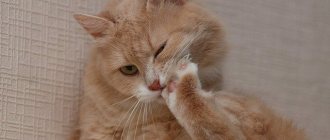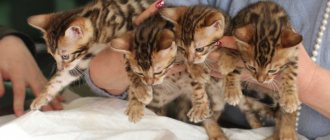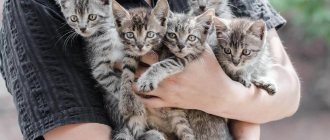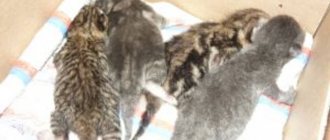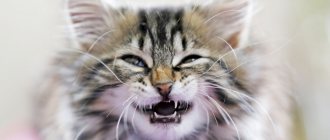In the first month after the birth of small kittens, only the mother cat needs to feed nutritious food rich in microelements. Feeding kittens will add some extra hassle to caring for the litter. For the first 3-4 weeks, newborns need exclusively breast milk. Then the babies begin to be fed and taught nutritious adult food.
Help the cat
The pet pleased the owners. Squeaking lumps were born. If the cat has given birth for the first time, the litter should not be too large. From 3 to 6 kids is ideal.
The mother is able to feed this number of kittens normally. If there are more of them, you will have to introduce complementary foods for the kittens, or, more correctly, supplementary feeding.
For these purposes, you can buy a cat's milk replacer. It is sold in good pet stores. It's not cheap, let's warn you right away.
You can make a substitute yourself. It is different from the store bought one, of course. But it has been tested by time and by more than one “cat person.”
- Take a liter of milk.
- Add two yolks to it.
- A teaspoon of sugar also goes here.
- Mix everything.
- Feed the kitten the heated mixture.
When to start feeding kittens - why exactly a month?
You can start feeding at any time, but it is at one month that they begin to lack milk. That’s why it’s worth giving extra food, and the feeder should be friendly. Before feeding, you can try to play with the baby to win him over.
Important!!! correctly determine when to start feeding kittens, since it is during the process of introducing complementary foods that the basic skills of a four-legged cat are formed. You will teach him to eat food on his own, he will receive the necessary knowledge.
We introduce complementary foods
If the cat feeds the children herself, the feeding schedule will be different. The baby begins to open its eyes approximately two weeks after birth. This is the time to start feeding the kittens their first food.
On the Internet they say that it should be introduced at 3-4 weeks of life. This is wrong. Kittens grow and require more food. But mother's milk doesn't get any better. Kittens need additional vitamins for active growth.
Where to start? As already mentioned, babies are fed from 14 days of age. It all starts with milk. It can be made according to the recipe described above.
The milk should be a little warm. We dip our finger in it and run it over the kitten’s lips. He will begin to fuss and lick his lips. As soon as you realize that there is milk on your lips, you give it your finger. Our task is to make the baby lick it. And gradually lower your finger into the saucer with milk. We carefully ensure that the baby does not choke by putting his face in it.
The saucer should be shallow, with low edges, so that the baby is comfortable. Two weeks of age is approximate. The fact is that at this time the babies' eyes open. More precisely, they should already be completely open. Then they begin to introduce complementary foods to the kitten.
Water in the diet of small kittens
Water plays a fundamental role in the formation of metabolism. The acute need for water does not appear while kittens consume liquid food. Even at the initial stages of introducing supplementary feeding, kittens are reluctant to drink or outright refuse water.
With natural feeding (by a cat) and liquid supplementary feeding, kittens can ignore pure water for up to 1.5–2 months.
Despite the natural reluctance of kittens to drink water, be sure to place a drinking bowl within the children’s access. Offer the kitten water during each feeding. Don't panic if your kitten refuses water but remains active and doesn't appear dehydrated. To make sure your baby isn't instinctively refusing water, wet your finger and touch his nose. The kitten will instinctively lick itself and become interested in water if there is a need for it.
Third week
Another week passes. The baby is already 21 days old. It's time to think about starting to feed kittens meat.
Previously, it was believed that babies should be given minced meat and porridge in meat broth. Now the position is different. Complementary feeding for a kitten begins with baby food. Of course, it must be meat or meat and vegetables.
Warm up the food a little. Take a teaspoon. We need half a spoonful of nutrition. We bring it to the kitten’s nose. The baby begins to actively sniff, fuss and try to lick the treat. If there is no last attempt, then take a little puree on the tip of your finger. And we pass it over the kitten’s lips. Someone recommends rubbing a treat on his palate, but on his lips - it’s more familiar and calmer. The sky can also be damaged.
Strictly follow the rule: one day - one new dish. There is no need to give your kitten porridge, meat puree and cottage cheese right away. Feed puree on Monday. On Tuesday, cook the porridge, and on Wednesday, give the cottage cheese.
What to do if the kitten does not want to eat on its own?
You can expand your baby’s diet with baby meat puree.
Usually, by the age of one month, the cat herself begins to try to accustom her cubs to food. Owners can purchase ready-made baby meat puree to help their pet. A few days later - vegetable. It is permissible to prepare food yourself with a consistency close to gruel. A kitten who has not yet figured out how to eat without help can smear food across the roof of his mouth.
A good method is to offer a treat by hand. First, drop a little gruel on your finger and let it lick off. Gradually move your hand to a bowl with the same product. Another option is to spoon feed, gradually moving to a bowl. There is no need to force-feed the kitten; you may have to postpone introducing food until the next day. Dry complementary foods are fed well soaked in water. Professional nutrition for kittens from the 1st month of Royal Canin Baby Cat will help solve the problem of self-feeding. An appetite stimulant is a great way to help train a kitten to a bowl. Recommended preparations for short-term use: catnip, 8 in 1 Excel Kittyvite Vitamin paste.
Add cottage cheese
Another useful product for feeding a kitten. They do it themselves. Take yogurt or kefir. The fattier these products are, the better the quality of the cottage cheese.
Pour into a saucepan, heat over low heat. We don't touch it for the first 5 minutes. Then take a spoon or slotted spoon and stir the product. It should not stick to the bottom of the pan.
When the curd begins to separate, sinking to the bottom, it is almost ready. It should be floating in a greenish whey. If the whey is this color, turn off the heat.
Next, take gauze folded in several layers. Place the cottage cheese on it. Gauze is placed in a colander to drain the whey from the curd. Then we hang a knot of gauze and leave it to ripen for 12 hours.
This cottage cheese is suitable not only for feeding a kitten. You can eat it yourself.
Prohibited foods for the diet
It is recommended to exclude the following products from the kitten’s menu:
- milk and fatty dairy products;
- fried and salted foods;
- smoked meats and sausages;
- pork;
- River fish;
- potatoes, tomatoes, grapes, citruses, pineapple, kiwi;
- chocolate and bakery products;
- bones of animals, birds or fish;
- food from a person's table;
- dog food.
To prevent your kitten from eating prohibited foods, you need to follow these simple tips:
- Do not allow the kitten to sit on the table while preparing or eating food.
- Don't feed table scraps.
- During the holidays, be on your guard - scents can tempt even the most well-mannered and obedient animal.
- Keep food out of the kitten's reach. If he shows interest, install special locks on the cabinet doors.
Don't let the kitten sit on the table
Prolonged feeding of a kitten with human food leads to metabolic disorders, diseases of the gastrointestinal tract, heart and blood vessels.
Poor quality of the finished food or intolerance to a certain type can cause digestive problems in the kitten. In this case, you should consult a veterinarian and choose a different type of food or a different type and brand of food; it is better to give preference to products with a higher price. Saving on the animal's nutrition will negatively affect its health and will lead to even greater costs for the treatment of diseases that arise as a result of eating low-quality food.
Nutrition up to one month of age
All of the above is given to the kitten before it reaches one month of age. Then new foods are introduced into the diet.
Chicken yolk begins to be given from 21 days. They just do it extremely carefully. They start with a grain, in the literal sense of the word. If the baby reacted normally to the product, they give a little more. And they closely monitor the baby’s reaction to the innovation.
General recommendations
If it is decided that the kittens will eat only natural food, it is advisable to accustom the pets to eating a variety of foods from the first month. You should not give your animal one product he loves and make it the main one in his diet. This can lead to digestive problems.
A great danger to a kitten's health is feeding human food in combination with ready-made food. It is also not recommended to mix expensive dry food with cheap wet food. It is better to leave only dry food, since low-quality wet food will do nothing but harm to the kitten.
Pay attention to the kitten’s fur as often as possible: if it is shiny and smooth, then the pet is healthy. If bald spots appear or the skin under the fur is irritated, you need to consult a veterinarian and purchase a special vitamin complex. But remember that in a good ready-made food, all nutrients and microelements are already balanced.
From a month to three
Complementary feeding of the kitten begins at the age of two weeks. We found this out. We know when and how to introduce meat, porridge and cottage cheese into the diet.
After the pet is 30 days old, its menu is gradually expanded.
In addition to semolina porridge, they begin to feed the baby rice, buckwheat and oatmeal. It is boiled in milk or water.
Instead of baby food, they give minced chicken or beef. They begin to feed the kitten with vegetables. They are boiled, pureed, and a little vegetable oil is added. You can mix it with minced meat so that your pet is more willing to start tasting it.
During this period they begin to give cheese. In very small quantities and no more than twice a week. Please note that not every kitten will like it. Some cats do not eat cheese throughout their lives.
From the age of two months, the pet is given meat. Choose lean varieties: chicken, turkey or beef. How to give: raw or boiled? There is active debate on this issue. Others say that raw meat can be given. It is frozen very well beforehand. When planning to offer it to your pet, defrost it and scald it with boiling water. Then finely chop.
Someone is leaning towards a boiled product. The meat is boiled well, cooled and cut into small cubes.
Boiled meat is not as healthy, but safer for feeding a kitten.
Features of complementary feeding of individual breeds
When introducing complementary foods and preparing a diet, you need to take into account the characteristics of cat breeds. For most species, standard rules apply. But there are breeds that have certain characteristics that require correction in the complementary feeding regime.
Ragdoll kittens have a genetic disease: hypertrophic cardiomyopathy (thickening of one of the walls of the heart ventricle) and joint dysplasia. Therefore, the list of prohibited products additionally includes: meat of geese and ducks, cream, and fatty sour cream. Their consumption negatively affects cardiac activity and disrupts metabolism.
Little ragdolls
Sphynx kittens (like other representatives of hairless breeds) have a high risk of developing cardiovascular diseases. They can only be given dietary meat: turkey or chicken, rabbit, beef. Pork should not be given to any cats, and especially not to sphinxes. To start feeding, raw or boiled veal is suitable.
A Sphynx kitten needs to be fed more often than a regular cat. Six to eight meals are recommended up to two months, four meals up to five months. At the age of six months, reduce the frequency of feedings to three times a day, and from the age of nine months, accustom them to two meals a day.
Sphynx kittens
Maine Coons mature late. Cats usually feed their babies for up to two months. These kittens do not need to be fed complementary foods until they are 8 weeks old.
Maine Coon kittens differ from all others in their large size. Accordingly, more food is needed. At the age of two months, kittens should receive 130 grams of meat, up to 40 grams of vegetables and dairy products, and about 15 grams of cereal. For other breeds, this is the norm for an adult cat.
Maine Coon kittens are larger than kittens of other breeds
From three months and older
The diet is expanding again. Now the baby is given offal, but only in boiled form, of course. Fish is also allowed for a growing child. Strictly seafood, boiled, without bones.
According to some reports, cream can be given to a kitten. We strongly ask you not to do this. This is too fatty a product. The baby's stomach can't handle it. A kitten will get diarrhea if you give it cream to drink.
Kefir is a different matter. You can add half a teaspoon of sugar to it and treat the kitten. The kid will appreciate this drink.
Starting from the age of three months, remove milk from your pet’s diet. It is replaced with kefir or natural yogurt.
Care in the first days
It is better to feed kittens by holding them. Like babies, they need to be held in an upright position after feeding so that they can burp, releasing excess air.
In the first 2 days
For kittens, it is enough to give 1 teaspoon of milk every 2 hours. The dose should increase as the animals grow. It is advisable to weigh the kittens every day and keep records. If they aren't gaining weight, that should be a red flag.
Starting from day 8
Babies should be given liquid vitamin preparations prescribed by a veterinarian every other day. Raw cow's milk is contraindicated for newborn kittens. You can use ready-made cat milk or dry formulas - cat milk substitutes, which are sold in veterinary pharmacies. In any of the above cases, you will need a bottle and nipple (some manufacturers of ready-made cat milk put the bottle and nipple inside a jar of dry formula). They can also be purchased at veterinary pharmacies. You can use a plastic eye dropper or syringe (without a needle). The main requirement is sterility. Bottles and teats should be cleaned and boiled regularly. The food supply is prepared for no more than 24 hours and stored in the refrigerator.
The food must be heated to 38ºC, and when giving it, you must ensure that the kitten sucks milk itself. Milk should not be introduced by force, as the baby may choke. When the kitten falls asleep or when milk bubbles come out of his mouth, this means that the baby is already full. It is important that kittens suckle themselves through the narrow holes in the nipple and prepare themselves for the “drinking work”. Do not give milk through a wide opening. This often leads to milk entering the respiratory tract and causing pneumonia.
In the first 3 weeks
The kitten should be given 1 teaspoon of artificial food 7-8 times a day (every 2-3 hours, and at night too) with a night break of 5-6 hours. Gradually, the number of feedings should be reduced, increasing the amount of food fed at a time.
At the age of 15-20 days
Teeth are starting to cut, and the cat is not getting enough milk. From this period, kittens need to be fed, gradually transferring them to regular food.
How a kitten learns to eat on its own
Kittens are naturally curious.
They have a wonderful sense of smell and will be extremely focused on sniffing their mother's face after she has eaten. The bravest ones will try to lick their mother's lips. This is a signal that babies are ready to try different foods. If kittens grow up with their mother, then the cat herself will take them to the bowl and teach them everything. But a baby without maternal supervision will have a hard time. Here all responsibility passes to the owner:
- First, food is offered on a finger or spoon. The baby cannot handle the bowl. Most likely, he will step on it with his paws and immediately turn it over. The first should be milk. The kitten licked it and wants more? He will fuss, meow loudly and show interest in every possible way. In this case, you can offer a saucer or bowl.
- First, let your baby sniff the bowl. Then you need to lightly poke his muzzle into the food. If he likes it, he will start lapping it up.
- At first, the kitten may choke (he will snort or sneeze), climb into the bowl with his paws, and turn it over. The owner needs to be patient. Quite quickly the baby will figure out what's what and begin to eat more carefully.
Possible problems when transitioning to self-feeding
When switching to self-feeding, a kitten may experience a number of problems. These include:
- Gastrointestinal tract disorder. This may mean the food is not suitable for your baby. This most often happens when feeding cow's milk. In order not to aggravate the problem, you can offer the kitten a liquid, homogeneous porridge (for example, made from oatmeal), cooked with the addition of a small amount of milk (“for the smell”) or in low-fat meat broth. If you have constipation, don’t forget to massage your tummy after eating.
- Allergy. In kittens, like in humans, it can manifest as skin rashes and hair loss. The allergen should be identified and excluded. For a while, the kitten can be switched back to full breastfeeding or formula feeding.
- Psychological refusal of food. A categorical refusal to eat may mean that the baby is not yet psychologically ready to eat on his own. At the same time, the owner should offer him food in small portions, but not be persistent. In just a few days or a week, the situation may change radically, and the kitten will begin to show interest in its bowl and its contents.
I cooked oatmeal for my kittens using chicken breast broth. Before serving, grind it in a blender. The kittens felt the attractive smell of meat and ate with pleasure, especially since their mother ate a similar porridge, only with meat.
Artificial feeding
There are cases when a cat cannot or refuses to feed kittens, or the baby comes into the house as a newborn. In these cases, it is necessary to provide the pet with artificial feeding that is as close as possible to natural feeding. Specialized milk formulas are available in specialized stores; they are the best option. If such products are not available, you can use cream and milk with various additives in feeding. For example, add a teaspoon of vegetable oil and an egg yolk to a glass of milk.
Rules for artificial feeding:
- 6-7 feedings per day;
- breaks between feedings – from 2 hours;
- food volume per day – 24 ml;
- single dose – up to 5 ml.
Upon reaching 4 weeks of age, the breaks between feedings can be increased, increasing the number of feedings to four times a day. The procedure uses a nipple or pipette.
Supplements for breastfeeding
A cat's milk contains a full range of microelements necessary for kittens if she is well fed. The quality of feeding kittens can be determined by the condition of their fur, bone formation, and activity.
If babies receive good nutrition from their mother, they do not need feeding until 1-1.5 months. Breast milk provides everything needed for good growth and development.
If negative symptoms appear that indicate malnutrition, it is necessary to pay attention to complementary feeding. A food shortage can be judged by the condition of the kittens’ fur, lethargy, or constant restlessness, squeaks, and meows.
The cause may be the cat's poor diet or insufficient milk supply. Sometimes the mother abandons the kittens without allowing them to eat their fill. Regardless of the reason for the lack of nutrition, it is necessary to replenish it in order to provide babies with good conditions for growth.
How to teach a kitten to drink from a saucer
An overly hungry kitten will communicate its desire to eat with a loud, shrill squeak. He will crawl fussily and poke his face everywhere, as if looking for his mother cat.
How to teach your baby to eat himself
How often does this happen: a little kitten was brought to a new home, where all the furniture and cutlery had already been equipped for it, but the baby refuses to eat. For babies separated from their mother early, this condition is natural. The kitten didn’t even think about the fact that there was food other than mother’s milk. Even when he is hungry, he does not know how to eat himself and does not understand why his owner demands the impossible from him. You will have to try to teach the kitten to eat on its own.
It is best to start with milk - this is the only food that the baby currently knows. Warm cow's milk needs to be heated to a comfortable temperature and filled into a bowl. Be patient! A fluffy toddler can wander around a bowl for a long time, sniffing the contents incredulously and periodically backing away. Help the baby. You can soak your fingers in milk, then run them over the kitten’s face, or lightly poke its nose into the bowl. A clean baby will immediately begin to lick itself and snort, but at the same time it will like the taste of warm milk. Not immediately, but after several such shenanigans, the baby will understand how great it is to eat on his own.
It will be more difficult to teach a kitten to eat if the bowl is uncomfortable or not very clean and contains foreign odors. An ideal cat dish should smell only of fresh, warm food, not slide across the floor, and not force your pet into an awkward body position.
As soon as the fluffy bastard learns to drink milk on his own, it will be possible to switch him to porridge and baby food. Meat pate for kittens would be a good delicacy, but not all kids will immediately start tasting it. Some cubs need time to adjust to new food.
Owners use different tricks to get their pet to eat new delicacies. Sometimes they mix innovations with familiar food, and the kitten, without knowing it, becomes accustomed to various unfamiliar dishes. You can bring new food on your finger to the kitten's face. Sometimes the picky person plucks up courage and tries what the owner suggested.
Useful nuances
Every happy owner should know these little things:
- A kitten of any age should always have access to clean water. You need to change the contents of the water bowl 2-3 times a day. Sometimes hair and food debris get into the water, which can cause the animal to refuse to drink and suffer from thirst.
- Kittens can get into the bowl with their paws, you can’t scold them for this. This is how kids enjoy the delicious food given by their beloved owner. If a person scolds a pet, the cat develops a fear associated with eating, and this then affects the upbringing of the baby.
- If your baby relieves himself regularly, it means he is getting enough food.
And most importantly: you don’t need to worry too much. There are no cats who would prefer to live on milk all their lives. Sooner or later, the pet will stop its tricks and start trying new things.
Is it possible to keep newborn kittens together?
If there are several kittens, they are usually kept together. This makes it easier for babies to stay warm by snuggling together. Living warmth and the presence of relatives calms and creates a feeling of security.
But there are exceptions to every rule. During the first week, kittens should not be left with each other unattended, as their umbilical cord has not yet healed. Up to the age of one month, observe how babies interact with each other. Without round-the-clock access to the mother's breast, hungry kittens can cling to each other. This can be very dangerous - babies leave each other serious bruises, most often in the genital area and abdomen. They can suck ears and tails. If nothing is done, inflammation begins, especially in weak kittens.
To prevent kittens from sucking each other, they need to be fed and picked up as often as possible. But most often we have to separate the kids. Be careful.
The sucking reflex persists in orphan kittens for a very long time. Sometimes a cat raised without a mother sucks the owners fingers, earlobes, clings to the skin of the hands or chews hair until death.
Diet rules with industrial feeds
If the owner decides that his pet will only consume ready-made diets, whether dry or canned, from this moment on it is recommended to adhere to certain rules:
- Natural food and industrial nutrition are combined only during the period of accustoming the kitten to store-bought canned food or dry food. In the future, the pet should only be on one type of feeding. Constantly combining natural and industrial food can lead to an imbalance of vitamins and nutrients, which will not have the best effect on the condition and functioning of the digestive system and the entire body.
- A kitten accustomed to commercial diets should always have fresh, clean water in its bowl. For an animal that eats only dry food, water is the only source of liquid. The owner must ensure that his pet regularly drinks water. If the kitten does not drink it often, you should train it. Lack of fluid when eating dry food can further provoke the development of urolithiasis.
- It is recommended to give preference in industrial food to wet canned food, as they are more nutritious, tastier and contain moisture.
- To make the canned food even tastier and more aromatic, especially if the animal has difficulty getting accustomed to ready-made food, it is recommended to heat the jar to 40°.
- It is not recommended to give dry and wet food at the same time, mixing them in the same bowl. The optimal option for feeding a kitten: the base is dry food, and canned food is periodically included in the menu.
- You only need to purchase a ready-made diet with a note indicating the appropriate age. Giving small animals the same industrial food that is intended for adults is prohibited.
Ready-made food for kittens
Ready-made food is available in the form of dry food or wet food - jelly-like mousses, canned food and treats.
As already mentioned, if you do not want to risk your pet’s health, you need to choose premium and super premium food.
Cheaper feeds do not have high quality raw materials and may contain harmful preservatives and dyes, which, when used for a long time, affects the health of the animal.
To feed a kitten from 1 to 4 months, use wet mousses or dry croquettes, which are soaked in water. After 4 months, they switch to dry food; it is useful to combine it with wet food from the same manufacturer - mousses and canned food. Occasionally you can pamper an older kitten with treats.
Important! When feeding dry food, ensure the kitten has constant access to water.
Dry food for kittens
Among super-premium dry food, the following are deservedly popular:
"Royal Canin", "Purina ProPlan", "Iams/Eukanuba".
Premium dry food:
“Hills” (Hills), “Eagle Pack” (Eagle Pak), “Pro Pak” (Pro Pak), “Nutro Natural Choice” (Nutro Natural Choice).
Characteristics that you should pay attention to when selecting high quality feed:
- They do not contain soy, by-products, chemical dyes, preservatives, or odor imitators;
- Meat comes first in the description of the food composition;
- The number of additional ingredients is at least 4-5, usually 8 or more.
Classification and features of industrial feeds
On mobile, you can scroll the table horizontally with your finger.
| Name | Advantages | Flaws |
| Economy class Darling, etc. | low cost |
|
| Premium class Doctor Alders, etc. |
|
|
| Super-premium class Bosh, etc. |
| the cost is quite high |
| Holistics Eagle Pack Holistic Select Felidae, etc. |
| the cost is high, not affordable for everyone |
Economy or medium food refers to a type of industrial food that is secretly called fast food for representatives of the cat world. This is the cheapest, most budget option, which has many disadvantages. Such food is made from the cheapest, low-quality products.
There is practically no meat in the composition. The meat part is represented mainly by waste. To enhance the taste of these products, chemical preservatives, flavor enhancers, flavorings, as well as catnip, which is an analogue of valerian, are added to the composition. Giving such food on a regular basis is highly discouraged, as this can lead to serious problems with the digestive system and health of the animal.
Super-premium class - they cost more than economy class, but they do not always meet the requirements. The advantage of such foods is that they do not contain food colors or flavors. They contain more meat than in economy category feeds, and the taste is a level higher. These types of feeds are quite well accepted by the animal’s digestive system.
Holistics are the most expensive class of cat food, but their quality is appropriate. The composition contains a large amount of natural, good meat. No dyes or flavor enhancers. The composition of the food fully corresponds to natural nutrition.
Recommended canned foods
On mobile, you can scroll the table horizontally with your finger.
| Name of food | Advantages | Flaws |
| Bosh Sababelle Super premium class |
| The food contains large quantities of maize and cellulose - components that can provoke a food allergy in a kitten. |
| Pro Plan Junior Premium class |
| The composition contains a high concentration of protein of plant origin. The food contains corn and soy - products that provoke allergic reactions. Preservatives are also present in the composition. |
| Hills Premium class |
| A high concentration of carbohydrates, which are poorly absorbed by the kitten’s digestive system, there are components that can cause allergies, canned food contains a lot of water and broth. |
